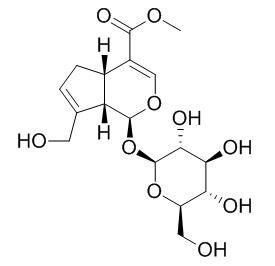Natural Products
Geniposide
| Catalog No. | CFN98261 |  |
| CAS No. | 24512-63-8 | |
| Molecular Weight: | 388.4 | |
| Molecular Formula | C17H24O10 | |
| DBs | [PubChem]:274952247 [ChEMBL]:5299 [PCIDB]:320 |
Standard InChI:
InChI=1S/C17H24O10/c1-24-15(23)9-6-25-16(11-7(4-18)2-3-8(9)11)27-17-14(22)13(21)12(20)10(5-19)26-17/h2,6,8,10-14,16-22H,3-5H2,1H3/t8?,10?,11?,12-,13+,14?,16?,17+/m1/s1
Biological Activity
Geniposide, a major iridoid found in fruit, is widely used in Asian countries for its anti-inflammatory, and anti-apoptotic activities, the anti-apoptotic activities is due to its modulation of and -related factors (p53, Bax, Bcl-2 and Caspase-3) in LPS-induced mouse mastitis. [1]
Geniposide, an agonist for GLP-1 receptor, regulates expression of anti-oxidative proteins including HO-1 and Bcl-2 by activating the transcriptor of p90RSK via MAPK signaling pathway in PC12 cells.[2]
Geniposide is highly effective in inhibiting acute lung injury and may be a promising potential therapeutic reagent for acute lung injury treatment.[3]
Geniposide inhibits high glucose-induced cell adhesion through the NF-κB signaling pathway in human umbilical vein endothelial cells.[4]
Geniposide may attenuate memory deficits through the suppression of mitochondrial oxidative stress, thus, geniposide may be a potential therapeutic reagent for halting and preventing Alzheimer's disease progress.[5]
Product
References
[1] Song X, Guo M, Wang T, et al. Life Sci, 2014, 119(1–2):9-17.
[2] Liu J, Fei Y, Zheng X, et al. Neurochem Int, 2007, 51(6-7):361-9.
[3] Fu Y, Liu B, Liu J, et al. Int Immunopharmacol, 2012, 14(4):792-8.
[4] Wang G F, Wu S Y, Wei X, et al. Acta Pharmacol Sin, 2010, 31(8):953-62.
[5] Lv C, Liu X, Liu H, et al. Curr Alzheimer Res, 2014, 11(6):580-7.
[6] LIAO Yan-hua, HAN Feng, MA Li. Drugs & Clinic, 2013, 28(2):191-193.
Product Use Citation





